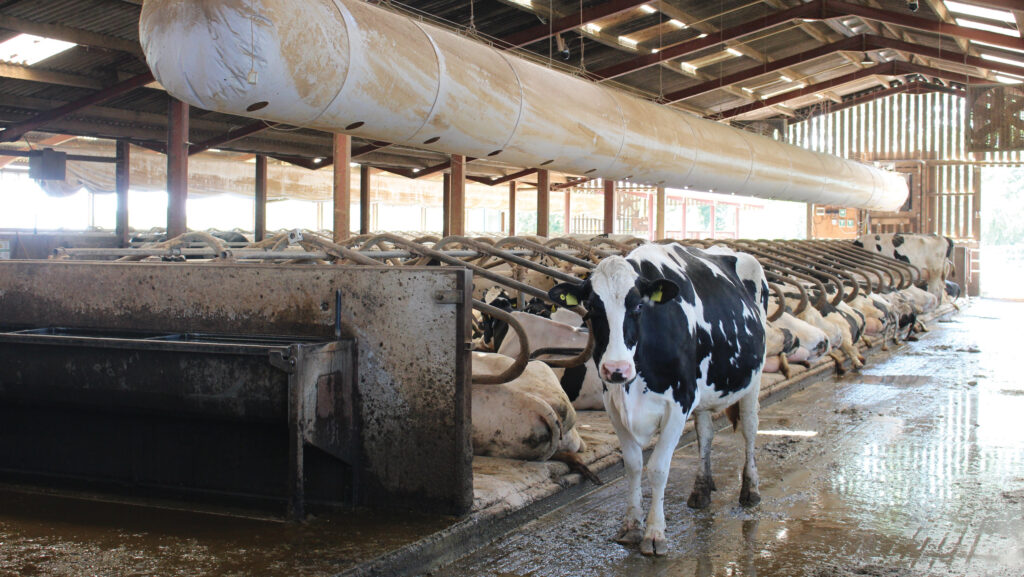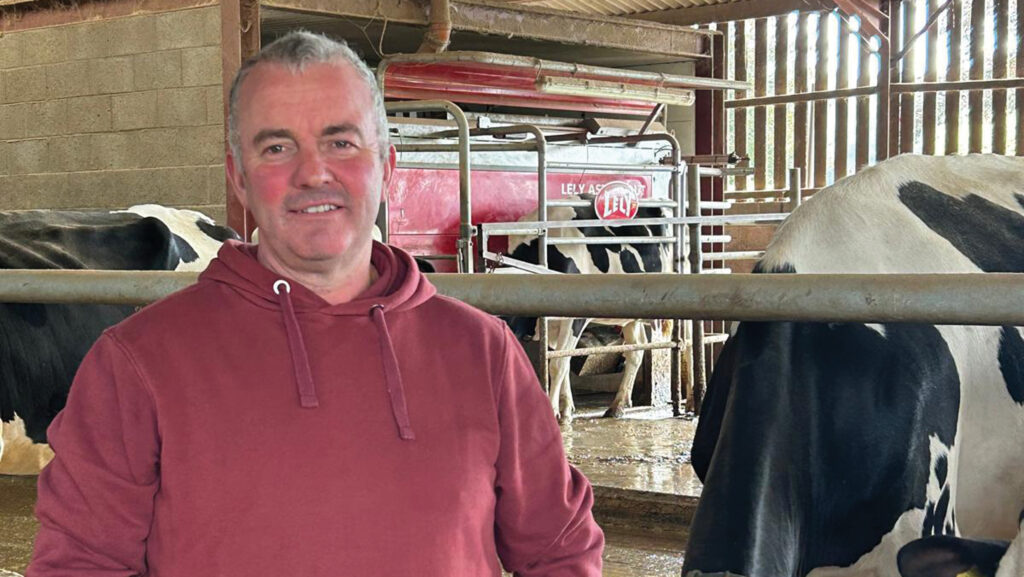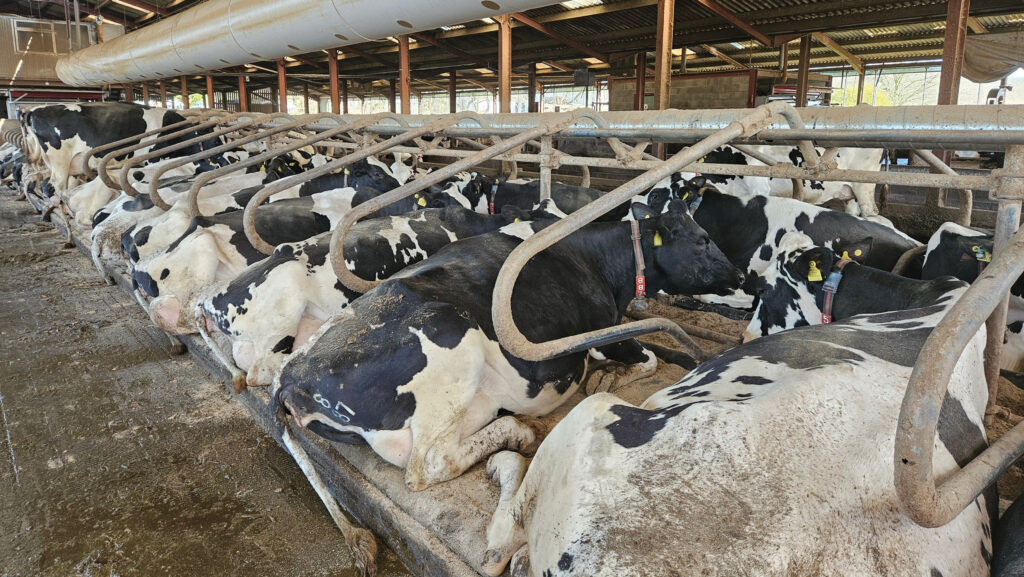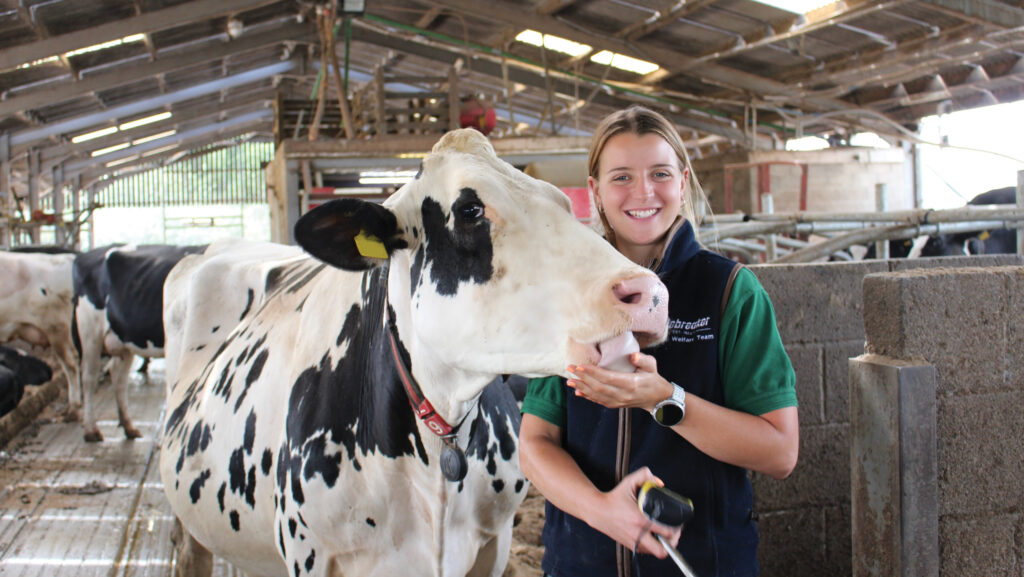How cow-controlled climate ventilation can reduce lameness
 © Jo Clark
© Jo Clark A combination of positive pressure tubes, side curtains and cooling has helped cows to cope better with heat stress, maintain yields and improve foot health at Graig Olway, in Monmouthshire.
Since 2019, farmer Russell Morgan and his partner Sarah Smith have been working alongside vet Sara Pedersen of Farm Dynamics to reduce lameness in their herd.
They have lowered the incidence from 45% to less than 10% using a holistic approach, including fortnightly mobility scoring, prompt treatment and improved cow comfort.
See also: A guide to mitigating heat stress in housed cattle
However, there were still periods when lameness was higher than ideal.
As Sara recalls: “We had a consistent rise in lameness during – and subsequent to – periods of heat stress. So that’s when we started looking at alternative options for heat-stress mitigation.”
Farm facts
Graig Olway, Monmouthshire
- 283ha family farm growing grass, maize, wheat and barley
- 340 Holstein cows
- Yielding 11,000 litres at 3.9% fat and 3.35% protein
- Milked through six robots
- Supplying Muller on an aligned contract
Heat-stress effects
When heat stressed, cows stand up for up to three hours extra a day in an attempt to cool down, which raises the risk of sole bruising and ulcers.
They also tend to perch in cubicles and bunch in darker areas of the shed, further increasing pressure.
Russell started by trying to improve natural ventilation, increasing the gap between space boarding, then removing it altogether.
This helped, but left the building exposed during inclement weather, and did not massively improve air flow in the older sheds with low roofs.

Russell Morgan © Sarah Smith
The next step was to install side curtains that would automatically open and shut, depending on air speed and temperature. However, he still had to artificially ventilate buildings during still or very hot periods.
Russell was interested in the Animal Centred Controlled Environment for Dairy (ACCED) Project (see panel) led by Galebreaker and used his business as a trial farm.
The aim was to look at integrating different ventilation systems, which included Galebreaker’s positive pressure tube ventilation (PPTV) system with variable-rate fans, side curtains and cooling systems. Smartbell ear tags were also put in 80 cows.
Tube design principles
PPTV uses a fan to push fresh air down a tube and deliver it evenly through a shed via a series of holes.
Although widely adopted in milking cow sheds in the US, they tend to be used in UK calf buildings.
With calves, the idea is to deliver fresh air but no draughts at calf height, whereas in milking cows, high air speeds are needed directly over cows’ backs to cool them.
At Graig Olway, tubes are located over the cubicles, with a hole positioned over each lying space.

Lowered heat stress and better cow comfort increased lying times © Jo Clark
The idea is that if cows are kept cool when they are lying, they will be less likely to stand with heat stress.
The size of the fan, and length and diameter of tube varies according to the length of the cubicle run and is designed to deliver 2-5m/second of clean air.
As the design is shed specific, Sara says it’s important to seek specialist advice.
The fans are linked to temperature humidity sensors in the shed to switch them on and off; Russell manually changes the fan speeds.
The curtains automatically rise and fall depending on wind and temperature information from a weather station.
Benefits
The hybrid system has had a marked impact on foot health, says Sara.
“The mobility scores this summer have been pretty steady, whereas before we’d have seen a spike in relation to each period of heat stress,” she says.
There have also been no new sole ulcer cases in the last 3.5 years – in 2019, 30% of the herd had them.
This is linked to improved cow comfort/lying, prompt identification and treatment, and less heat stress.
Similarly, there has been no drop in feed intakes – they used to dip by 2-3kg a head a day during hot weather. Yields too have shown no significant fall.
“In September 2023, I think we [dropped] about 2-3 litres a cow because of the heat. And it doesn’t come back very easily from some of them,” says Russell.
Cooling costs
Each positive pressure tube costs about £4,000, and PPTV running costs are attractive.
Russell’s calculations show he would have needed eight cyclone fans to cover an area, compared to one PPTV system that uses about a third of the electricity.
He is excited by potentially having a fully automated system that could regulate the environment in specific areas of the shed based on the temperature humidity index and cow behaviour.
Animal Centred Controlled Environment for Dairy project

Chloe Rodriguez © Jo Clark
Controlling a building’s environment automatically in response to cow behaviour, rather than shed temperature and humidity, was one of the questions asked as part of research.
The research was funded by the Innovate UK BridgeAI programme, led by Galebreaker in partnership with Smartbell between 2023-25.
The project looked at hybrid ventilation and controlling systems using building temperature humidity index (THI).
It assessed the feasibility of using cow body temperature and movement information collected via Smartbell ear tags.
The idea was to see if artificial intelligence (based on machine learning around cow behaviour and heat stress) could be used to control ventilation – changing conditions based on what the cow is experiencing.
Chloe Rodriguez, Galebreaker’s animal welfare specialist, says typically a THI of 68 has been used to determine when heat stress occurs.
However high yielding animals tend to experience stress at lower levels.
That means there is scope to adapt building controls based on cow indicators and switch on ventilation as soon as some cows show signs of stress.
To improve efficiencies, ventilation systems were activated as, and when, needed at Graig Olway:
- Side curtains would open automatically as soon as building temperatures started to rise to encourage natural ventilation
- PPTV would then switch on if temperatures continued to climb
- The speed of variable rate fans in the PPTV system would increase in response to increased heat stress risk.
- In very hot conditions, an evaporative cooling system would then kick in, using water in the system to cool air as it comes out of the tube.
Initial findings
- In September 2023’s sustained heatwave, second and third lactation cows producing 45 litres/day had a greater yield drop, and slower recovery, than first lactation animals, highlighting individual cow reactions.
- Information from smart ear tags could control ventilation in theory, but more development is needed to make it commercially viable.
- The evaporative-cooling system reduced the temperature coming out of the tubes by 8C.
- Cows continued to bunch despite ventilation systems. This could be due to habit, or influenced by feeding times, with cows possibly getting hot at the feed fence.
- Final results at the end of 2025.
